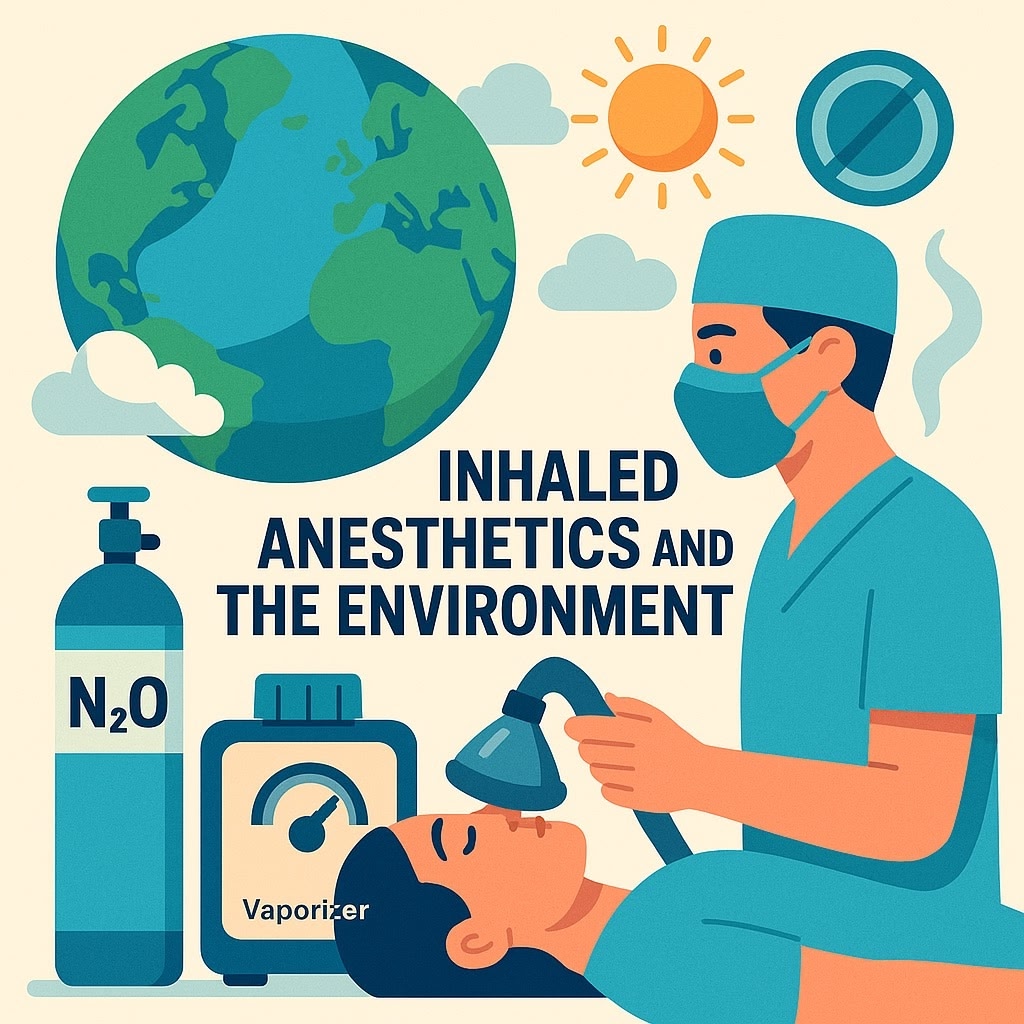👉👉 🇺🇸 All Posts 🇬🇧 / 🇯🇵 記事一覧 🇯🇵 👈👈
♦️ Introduction
Hearing that “inhaled anesthetics have a negative impact on the environment” may come as a surprise to many 😳. While hospitals are places designed to protect patients’ health, the medical practices carried out within them also emit greenhouse gases, which—although quite limited—do affect the global environment (in fact, the contribution is estimated to be only about 0.01–0.1% of the total).
The operating room (OR) in particular is often described as a “hot spot” of hospital energy use and greenhouse gas emissions. Although the overall impact is small, this is an area in which clinicians themselves can make daily choices, and as a result, legal measures are now being taken—for example, the European Union has decided to ban the use of desflurane starting in 2026 🌍. Incidentally, nitrous oxide (N₂O) consumption in anesthesia is small; the vast majority is industrial 🏭.

♦️ Keywords and Anesthetic Agents
🔷 Key Terms ☝️
- GWP (Global Warming Potential)
This is a measure of how much warming a gas causes over 100 years, compared to CO₂ = 1. The higher the number, the more it contributes to climate change. - Atmospheric Lifetime
How long a substance remains in the atmosphere. This ranges from several years to centuries, and the longer the lifetime, the greater its cumulative impact on the environment. - ODP (Ozone Depletion Potential)
An index of a substance’s potential to destroy stratospheric ozone. Notably, nitrous oxide (N₂O) is problematic in two ways—it contributes both to global warming and ozone depletion.
🔷 Environmental Impact Data of Each Agent 💻
Comparing representative inhaled anesthetics and N₂O (a gaseous anesthetic):
- Sevoflurane
GWP is about 130 and atmospheric lifetime is about 1 year, both relatively low. Thus, it is often positioned as “the anesthetic with the lowest environmental burden.” Perhaps the most eco-friendly?! - Isoflurane
GWP is around 510, higher than sevo, with a lifetime of about 3 years. - Desflurane
On a completely different scale: GWP is about 2540 and lifetime about 14 years. Its environmental impact is overwhelmingly large, and internationally its use is being phased out (even though it was only relatively recently launched in Japan… 😅). - Nitrous Oxide (N₂O)
GWP is moderate at 273, but its atmospheric lifetime exceeds 110 years, and it is also the main culprit of ozone layer destruction. Thus, it is regarded as “the anesthetic gas with the most serious long-term environmental impact.”
☝️ Note: Difference between volatile and gaseous anesthetics
- ✅ Volatile anesthetics: Liquids that must be vaporized using a vaporizer (sevo, des, iso).
- ✅ Gaseous anesthetics: Already gaseous at room temperature and pressure, used directly (N₂O).
🔷 Estimated Emissions in Practice
One study calculated the CO₂-equivalent (CO₂e) emissions for “1 MAC, low fresh gas flow (0.5 L/min), for 1 hour”:
- Sevoflurane: ~0.6 kg CO₂e
- Isoflurane: ~1.4 kg CO₂e
- Desflurane: ~34 kg CO₂e
- N₂O: ~16 kg CO₂e
In other words, desflurane has about 58 times the warming impact of sevoflurane, and N₂O more than 25 times. This means that “just one hour of anesthesia” can equal the emissions of driving a car several hundred kilometers 🚗😳.
♦️ Problems with Each Anesthetic
🔷 Specific Problems of Nitrous Oxide (N₂O)
Nitrous oxide has some unique issues: not only is its GWP moderate, but…
- It is an ozone-depleting substance 🌍🔨
In 2009, Science reported N₂O as “the single most important ozone-depleting substance of the 21st century,” and since then it has been regarded as a double threat. - High pipeline leakage 🚰
N₂O is often supplied via central piping, but audits have shown leakage rates of 70–95%. Shockingly, in some facilities more N₂O leaks into the environment than is actually used for patients. In Japan, a nationwide survey has begun to clarify the situation. - Spread of mitigation technology 👍
Recently, destruction devices (“cracking devices”) capable of breaking down >99% have been introduced in some facilities (though costly). Furthermore, central piping systems are being removed, and in certain settings (obstetrics, dentistry, emergency departments) N₂O is shifting to cylinder use only. Some new hospitals are designed without central N₂O piping from the outset.
🔷 Volatile Anesthetics (Sevoflurane, Isoflurane, Desflurane)
Among volatile agents, desflurane stands out for its enormous environmental burden.
The EU will prohibit its use in principle starting in January 2026, and the UK’s NHS has already phased it out as of 2024. Globally, opportunities to use desflurane will likely continue to diminish.
Sevoflurane and isoflurane remain in use, but the key here is “low-flow anesthesia” (of course also effective for desflurane). The lower the fresh gas flow, the less anesthetic consumption and environmental emission. Maintenance flows of ≤1–1.5 L/min, and sometimes 0.5 L/min, are practiced—though with specific caveats (to be discussed in future features).
Notably, concerns that “low-flow sevoflurane carries nephrotoxic risk” are being challenged. Recent reports suggest that even at low flows, there is no clinical evidence of harmful renal injury 😊.
🔷 Practical Measures Clinicians Can Take ☝️
What anesthesiologists and perioperative care teams can realistically do includes:
- Basically avoid desflurane (sorry to the manufacturers 😅).
- Avoid N₂O in principle; if needed, use cylinders instead of central piping.
- When using inhaled anesthesia, make low-flow anesthesia the standard.
- Consider TIVA and regional anesthesia—options that avoid inhaled agents entirely.
- Introduce gas capture or destruction systems to directly reduce emissions.
- Work at the institutional level: especially N₂O piping audits and decommissioning are organizational, not individual, efforts.
📝 Summary (Take Home Points)
- Desflurane and N₂O have particularly large environmental impacts, and avoiding their use is desirable (a global trend?).
- If inhaled anesthetics are used, low-flow anesthesia is immediately actionable and effective for reducing emissions.
- Consider anesthetic techniques that do not use inhaled agents, such as TIVA and regional anesthesia.
- At the facility level, discontinue N₂O piping, and when needed, use cylinders or destruction devices.
🔗 Related articles
- to be added
📚 References & Further reading
- OpenAnesthesia. Environmental Impact of Desflurane. Updated 2024.
Summarizes key data such as desflurane’s GWP (2540) and lifetime (14 years). Compares environmental impacts of volatile anesthetics and recommends alternatives (sevo, iso, TIVA, low-flow). - IPCC AR6. Climate Change 2021: The Physical Science Basis.
Provides the latest greenhouse gas coefficients. Defines N₂O GWP100 as 273 (previously 298 in AR4). These values are standard for assessing global warming impact. - Ravishankara AR, et al. Nitrous Oxide (N₂O): The Dominant Ozone-Depleting Substance Emitted in the 21st Century. Science. 2009.
Demonstrated that N₂O is the most important ozone-depleting substance of the 21st century, emphasizing its dual role in warming and ozone depletion. - Regulation (EU) 2024/573 – EU F-gas regulation (desflurane prohibition).
EU regulation on fluorinated gases. For anesthesia, it stipulates that desflurane use will be prohibited from January 2026, except when no medical alternative is available. - NHS England. Delivering a Net Zero National Health Service. 2024.
NHS strategy toward “Net Zero.” Achieved desflurane elimination in 2024. Also outlines measures such as N₂O piping removal and destruction device implementation. (Guidance: Desflurane decommissioning and clinical use). - Association of Anaesthetists. Environmentally sustainable anaesthesia. Anaesthesia. 2020.
Comprehensive guidance on sustainable anesthesia practice: low-flow techniques, N₂O restriction, TIVA/regional anesthesia recommendations. - APSF Newsletter. Patient Safety and Low-Flow Anesthesia.
States that sevoflurane at <1 L/min can be safely used under appropriate conditions and monitoring. - Low-Flow Sevoflurane is Safe, Economical, and Better for the Environment 2023
Concludes that low-flow sevoflurane is safe, environmentally beneficial, and economical. The outdated FDA label recommending higher flows is obsolete; practice should shift toward evidence-based low-flow use.

コメントを投稿するにはログインしてください。